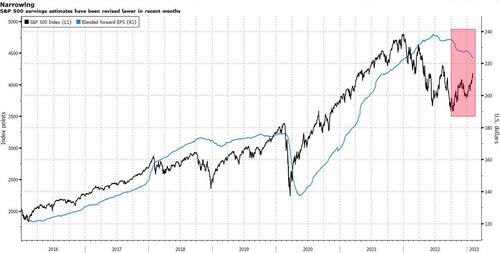Profit Recession Is Already Priced Into Stocks
By Jessica Menton, Bloomberg Markets Live reporter and analyst
There’s a little bit of good news for investors worried that stock prices are going to be pummeled by shrinking corporate profits. The drop so far seems largely priced in.
When the S&P 500 Index hit a low in October, the market was effectively factoring in a 15% decline in earnings-per-share over the next 12 months, according to Bloomberg Intelligence’s fair-value model.
But the reality — at least for now — hasn’t been quite so grim.
With the fourth-quarter results from more than half of the S&P 500 companies already in, earnings per share have fallen 2.8% from a year earlier, according to data compiled by Bloomberg Intelligence. That’s less than the 3.3% drop expected before earnings season began.
The smaller-than-anticipated drop suggests that the profit contraction isn’t beginning as badly as once feared, lending support to share-price valuations. That’s likely one reason why the market is rewarding companies that exceed expectations and even dialing back the punishment of those that fall short.
“This earnings season was already projected to be pretty bad,” said Michael Casper, an equity strategist at Bloomberg Intelligence. “When results come in line with projections or slightly worse than expected, it’s clear that investors had already priced that into stocks so equities aren’t going to get punished as much this time around.”
That doesn’t mean that stock investors are in the clear, particularly given the broad uncertainty about how long the Federal Reserve will keep monetary policy tight to ensure that inflation continues to come down. As a result, the worst of the profit hit may not come until the economy slows further or even lapses into a recession, which has raised some concerns about whether price-to-earnings ratios are too high after the S&P 500’s nearly 15% rebound from the October trough.
“The fundamentals have started to change,” said Rob Haworth, senior investment strategist at U.S. Bank Wealth Management.
“When does the Fed reach its peak rates? Will inflation slow sufficiently in 2023? Will there be a reset in corporate earnings? We’ve gotten progress in all three that has been supportive for equity markets, but investors are still cautious given uncertainty with economic growth.”
The main locus of investors’ valuation concerns are the growth stocks that have benefited the most from the retreat of bond yields from last year’s peaks, since those rates are used to put a value today on profits that aren’t expected until years in the future. In fact, the forward multiples for technology, media and telecommunication shares in the S&P 500 have returned to levels above the pre-pandemic norm at around 20 times earnings, above the five-year average of 17.6 times shortly before the pandemic struck.
That may exert a limit on future gains, particularly after the recent surge in payroll growth cast doubt on speculation that the Fed would start cutting interest rates late this year. If a strong labor market keeps wage growth elevated and prevents inflation from coming down as fast as policymakers want, the bank may raise rates more aggressively — or hold them higher for longer — than the markets had been expecting.
“People are getting ahead of themselves with the Fed slowing down policy,” Casper, the Bloomberg Intelligence analyst, added. “It’s tough for stocks to move materially higher in the near term toward record highs. It’ll probably be a bumpy ride because there’s not a lot of room for equities to inflate further.”
Tyler Durden
Tue, 02/07/2023 – 15:00
Zero Hedge’s mission is to widen the scope of financial, economic and political information available to the professional investing public, to skeptically examine and, where necessary, attack the flaccid institution that financial journalism has become, to liberate oppressed knowledge, to provide analysis uninhibited by political constraint and to facilitate information’s unending quest for freedom. Visit https://www.zerohedge.com

